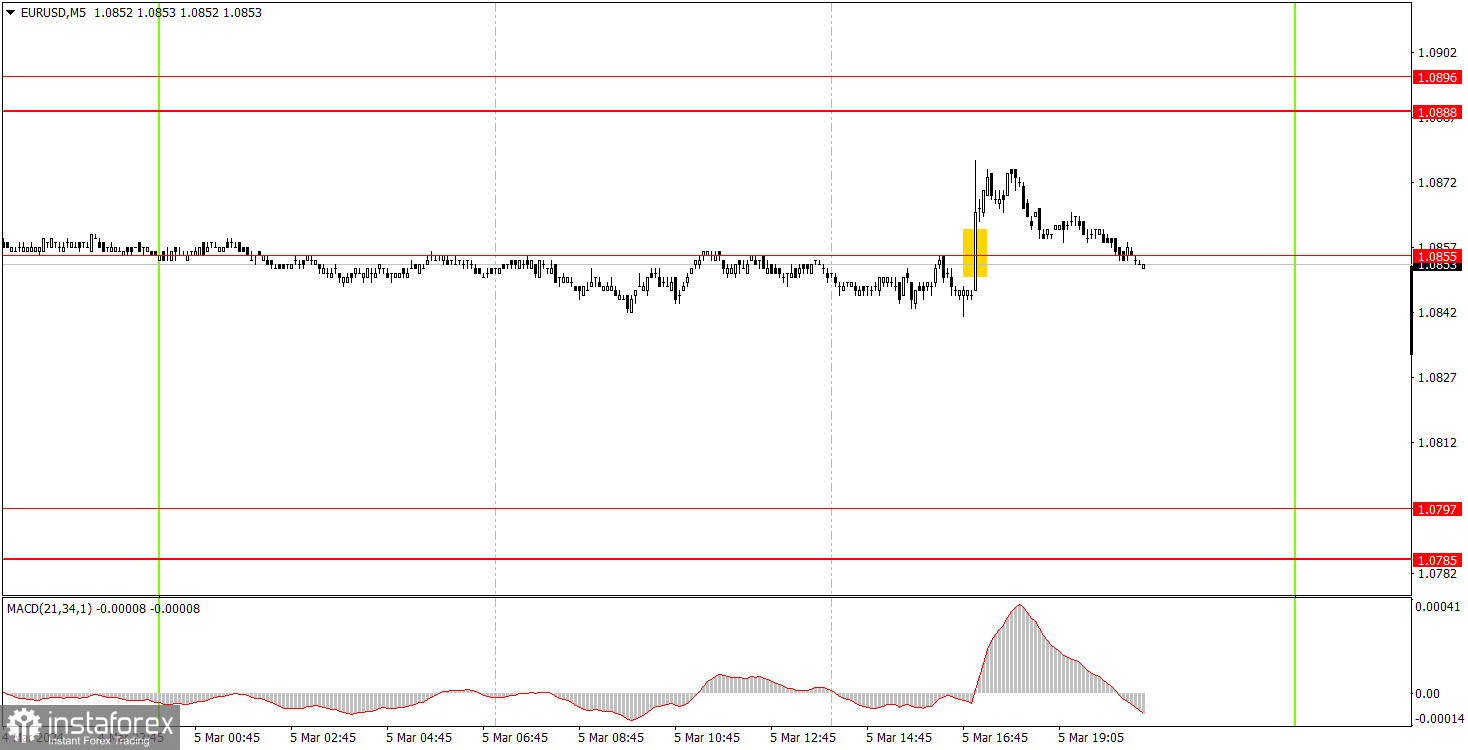Analyzing Tuesday's trades:
EUR/USD on 1H chart

EUR/USD continued its sluggish movement within a narrow channel. Volatility remained below 40 pips, which shows that there are no notable movements. During the day, the pair only briefly reacted, for about 5 minutes, when the U.S. ISM non-manufacturing PMI report was published. The latest values were weaker than forecasts and the previous reading, so the market sold the dollar. However, what did we see? A mere 25 pips? As we have previously mentioned, if there are no significant movements, then we shouldn't expect profitable trades. A mere 25 pips is practically nothing, even for the EUR/USD pair.
Thus, the euro continues to trade in a certain range, while the price is between the levels of 1.0785 and 1.0888. In the last three days of the week, there will be a significant number of important events. However, we cannot guarantee that we won't observe the same reaction as what we just saw, with only a 25-pip movement.
EUR/USD on 5M chart

The pair spent almost the entire day moving along the level of 1.0855 on the 5-minute timeframe. We do not consider the minor bounces from this level, as the price was practically flat throughout the day. The pair surged when the U.S. ISM index was published, and at that moment it surpassed the level of 1.0855. The euro stopped rising within 10-15 minutes, so there was no sense in executing this signal.
Trading tips on Wednesday:
On the hourly chart, EUR/USD is completely flat. We still expect the euro to resume its decline, which, in our opinion, should continue for quite some time, but the market is in no hurry at all. You may consider selling the euro after the price has settled below the level of 1.0785. Until then, the flat may persist.
The key levels on the 5M chart are 1.0568, 1.0611-1.0618, 1.0668, 1.0725, 1.0785-1.0797, 1.0855, 1.0888-1.0896, 1.0940, 1.0971-1.0981, 1.1011, 1.1043, 1.1091. On Wednesday, we can highlight the eurozone retail sales report, which may trigger a movement of 20-30 pips at most. The US will have more important events to look forward to. The ADP report, the JOLTs report, and Federal Reserve Chair Jerome Powell's speech in Congress. However, the values of the reports may turn out to be neutral, Powell may not provide anything new and important, and the market could remain in a state of apathy.
Basic trading rules:
1) Signal strength is determined by the time taken for its formation (either a bounce or level breach). A shorter formation time indicates a stronger signal.
2) If two or more trades around a certain level are initiated based on false signals, subsequent signals from that level should be disregarded.
3) In a flat market, any currency pair can produce multiple false signals or none at all. In any case, the flat trend is not the best condition for trading.
4) Trading activities are confined between the onset of the European session and mid-way through the U.S. session, after which all open trades should be manually closed.
5) On the 30-minute timeframe, trades based on MACD signals are only advisable amidst substantial volatility and an established trend, confirmed either by a trendline or trend channel.
6) If two levels lie closely together (ranging from 5 to 15 pips apart), they should be considered as a support or resistance zone.
How to read charts:
Support and Resistance price levels can serve as targets when buying or selling. You can place Take Profit levels near them.
Red lines represent channels or trend lines, depicting the current market trend and indicating the preferable trading direction.
The MACD(14,22,3) indicator, encompassing both the histogram and signal line, acts as an auxiliary tool and can also be used as a signal source.
Significant speeches and reports (always noted in the news calendar) can profoundly influence the price dynamics. Hence, trading during their release calls for heightened caution. It may be reasonable to exit the market to prevent abrupt price reversals against the prevailing trend.
Beginning traders should always remember that not every trade will yield profit. Establishing a clear strategy coupled with sound money management is the cornerstone of sustained trading success.





















